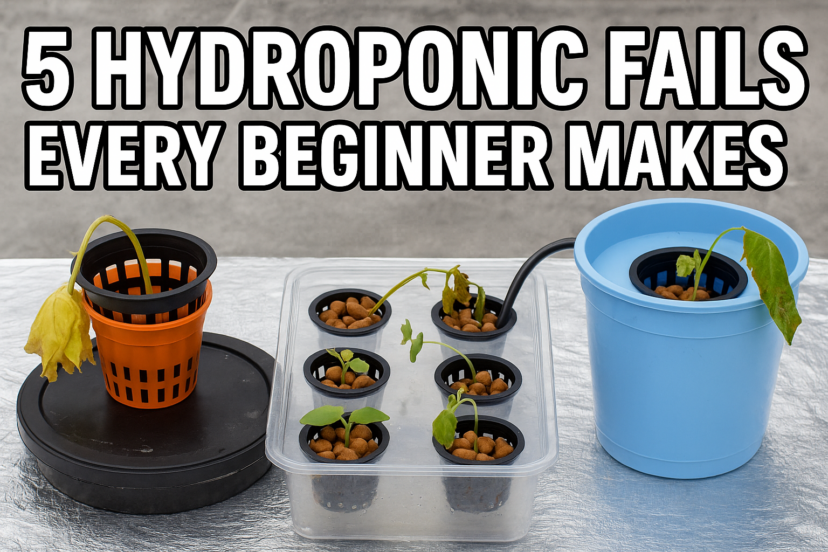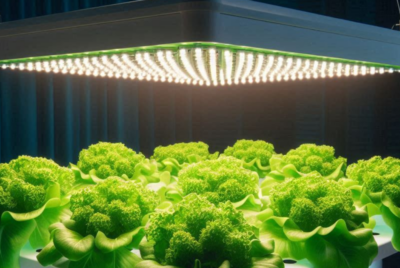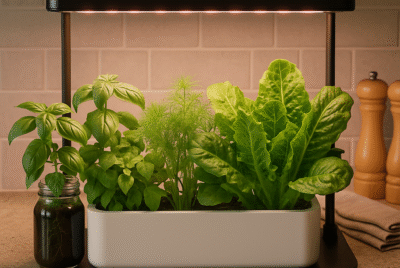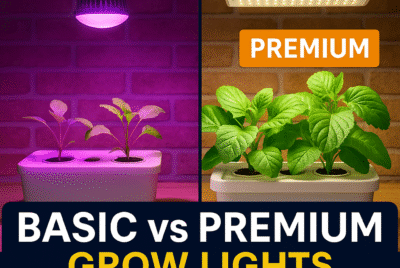5 Hydroponic Fails Every Beginner Makes (And How to Avoid Them)
Introduction
Hydroponics promises faster growth, higher yields, and the joy of growing fresh food almost anywhere. But let’s face it—when you’re starting out, it can also be a minefield of mistakes. The good news? Most beginner hydroponic fails are 100% avoidable with a little know-how.
Whether you’re setting up a Kratky bucket in your kitchen or investing in a full-scale NFT system, avoiding these common pitfalls can mean the difference between a thriving crop and a frustrating flop.
Let’s dive into the five biggest hydroponic fails that trip up beginners—and how you can steer clear of them.
Fail #1: Using Poor Water Quality
Why It’s a Problem
Water is the lifeblood of hydroponics. If your water is full of chlorine, heavy metals, or has an extreme pH, it can stunt plant growth or even kill your crop. Many beginners assume tap water is “good enough.” Spoiler alert: it often isn’t.
What Can Go Wrong?
- Chlorine and chloramine can damage roots and beneficial microbes.
- High levels of minerals like calcium and magnesium (hard water) can interfere with nutrient absorption.
- Incorrect pH can block nutrient uptake entirely.
How to Avoid This Fail
- Test Your Water: Use a simple water test kit or TDS meter before starting.
- Filter or Use RO Water: Consider an activated carbon filter or invest in a reverse osmosis (RO) system for the purest water.
- Adjust pH: Aim for 5.5 to 6.5 depending on your crops. Use pH up/down solutions as needed.
Pro Tip:
If you must use tap water, let it sit out overnight to evaporate chlorine—or use a dechlorinator designed for aquariums.
Recommended Products
- General Hydroponics pH Control Kit: Easy to use for adjusting water pH.
- APEC ROES-50 Reverse Osmosis System: Affordable RO filter for small grow setups.
- HM Digital TDS-EZ Meter: Measures water purity quickly and accurately.
Fail #2: Overcomplicating Your System
Why It’s a Problem
It’s easy to get caught up in the excitement of pumps, sensors, timers, and complex nutrient dosers. But beginners often forget that every added piece of tech is another point of potential failure. Many first-timers try to jump into advanced setups like NFT or aeroponics without understanding the basics.
What Can Go Wrong?
- Pumps can clog or break down, starving plants of water and nutrients.
- Timers can malfunction, especially cheap models, throwing off watering cycles.
- Too much complexity makes troubleshooting overwhelming.
How to Avoid This Fail
- Start Simple: The Kratky method or basic Deep Water Culture (DWC) setups are beginner-friendly and have few failure points.
- Add Technology Slowly: Once you master the basics, you can upgrade with pumps, air stones, and automation as needed.
- Test All Equipment Before Planting: Always run a system dry for a few days to check for leaks, timer malfunctions, or pump issues.
Pro Tip:
Many successful growers stick with simple systems even after years in the hobby. Consistency beats complexity!
Recommended Products
- VIVOSUN Air Pump and Stone Kit: Reliable starter for DWC setups.
- Kratky Hydroponic Bucket Kit: Simple, soil-free growing without pumps or electricity.
- BN-LINK Timer: Affordable and highly rated for controlling lights or pumps.
Fail #3: Nutrient Mistakes
Why It’s a Problem
Hydroponic plants rely entirely on you to provide nutrients. Unlike soil-grown crops, they can’t draw missing minerals from the earth. Beginners often overfeed, underfeed, or mix nutrients incorrectly, leading to poor growth, leaf burn, or even plant death.
What Can Go Wrong?
- Mixing incompatible nutrients can create precipitates (solid clumps) that clog roots and tubing.
- Overfeeding leads to “nutrient burn,” causing browning leaves and stunted growth.
- Underfeeding starves plants, especially during fruiting or flowering stages.
- Failing to adjust nutrient concentration (EC) as plants grow results in deficiencies or toxicities.
How to Avoid This Fail
- Use a Complete Nutrient Formula: Choose hydroponic-specific nutrient blends that contain macro and micronutrients.
- Follow Mixing Instructions Exactly: Measure carefully and mix in the recommended order. Usually, Part A before Part B to avoid clumping.
- Monitor Electrical Conductivity (EC): EC meters help track nutrient concentration so you can adjust feeding levels as plants grow.
- Flush Regularly: Every few weeks, drain and replace your nutrient solution to prevent salt buildup.
Pro Tip:
Start with leafy greens like lettuce or spinach. They’re nutrient-light feeders and more forgiving of small mistakes than fruiting plants like tomatoes or peppers.
Recommended Products
- General Hydroponics Flora Series Nutrients: Balanced and easy to mix for beginners.
- Bluelab EC Pen: Accurate and durable for monitoring nutrient strength.
- Botanicare Clearex: Helps flush excess salts and reset your nutrient reservoir.
Fail #4: Ignoring Light Quality & Timing
Why It’s a Problem
Light is as important as nutrients in hydroponics. Beginners often underestimate how much light plants need—or they choose the wrong type of lighting altogether. Too little light equals leggy, weak plants. Poor-quality light affects yield and nutrient uptake. And bad timing can throw off growth cycles completely.
What Can Go Wrong?
- Low light levels result in spindly stems and poor fruiting.
- Wrong light spectrum (too much red or blue at the wrong time) slows growth.
- Inconsistent light cycles confuse plants, leading to stress or flowering at the wrong time.
How to Avoid This Fail
- Choose Full-Spectrum LED Grow Lights: These mimic natural sunlight and work well for most hydro crops.
- Provide Sufficient Intensity: Aim for at least 25–40 watts per square foot for leafy greens. Fruiting crops may need even more.
- Use Timers: Consistent light cycles are key. For most vegetables, use 14–16 hours of light followed by 8–10 hours of darkness.
Pro Tip:
For leafy greens, prioritize blue spectrum light. For flowering and fruiting plants, include more red spectrum during the bloom phase.
Recommended Products
- Spider Farmer SF-1000 LED Grow Light: Affordable, efficient, and beginner-friendly.
- VIPARSPECTRA P-Series LEDs: Great balance of red and blue spectrums for all growth stages.
- BN-LINK Mechanical Timer: Simple and reliable for keeping light cycles consistent.
Fail #5: Poor Air Circulation & Temperature Control
Why It’s a Problem
Even with perfect water, nutrients, and light, poor air movement and temperature swings can ruin a hydroponic grow. Stale, humid air encourages mold, mildew, and pests. High temperatures reduce nutrient uptake. And low temps can stall plant metabolism entirely.
What Can Go Wrong?
- Powdery mildew and other fungal diseases thrive in still, damp air.
- High heat can cause nutrient lockout and plant stress.
- Cold temperatures slow or halt growth altogether.
How to Avoid This Fail
- Use Fans: Install clip-on or oscillating fans to keep air moving gently but continuously.
- Monitor Temperature: Keep grow spaces between 65°F and 80°F (18°C to 26°C) for most crops.
- Control Humidity: Aim for 50–70% humidity for leafy greens, and lower for flowering crops.
- Ventilate: If growing in a tent or small room, use exhaust fans to remove stale air and bring in fresh CO₂.
Pro Tip:
Plants “breathe” through stomata. Fresh, moving air ensures healthy gas exchange and prevents pest infestations.
Recommended Products
- VIVOSUN 6-Inch Clip Fan: Compact and adjustable for grow tents or shelves.
- AC Infinity Cloudline Inline Fan: Excellent for temperature and humidity control in enclosed spaces.
- ThermoPro TP50 Hygrometer: Affordable tool to monitor both temperature and humidity.
Pro Tips Summary
- Always test your water source before planting.
- Start with simple systems like Kratky or DWC.
- Stick to proven nutrient blends and avoid overfeeding.
- Invest in quality lighting and use timers for consistency.
- Keep air moving and monitor temperature and humidity daily.
Hydroponic Beginner Mistakes Recap
- Poor water quality damages roots and stunts growth.
- Overcomplicated systems increase failure points.
- Nutrient mistakes cause burn, deficiencies, or clogging.
- Light problems lead to weak or slow-growing plants.
- Bad air circulation encourages disease and pests.
Comparison Table: Common Fails & Solutions
| Fail | Problem | Solution |
|---|---|---|
| Poor Water Quality | Damages roots, nutrient lockout | Use filtered or RO water, test pH and TDS |
| Overcomplicated Systems | More parts = more things to break | Start with simple setups like Kratky |
| Nutrient Mistakes | Overfeeding, deficiencies, clogging | Use complete nutrient kits, monitor EC |
| Light Problems | Weak growth, poor yields | Invest in quality full-spectrum LEDs, use timers |
| Air & Temp Issues | Mold, heat stress, slowed growth | Use fans, ventilate, monitor temp and humidity |
FAQs
1. What’s the easiest hydroponic system for beginners?
The Kratky method or a basic Deep Water Culture (DWC) system—both have minimal moving parts and are very forgiving.
2. How often should I change my nutrient solution?
Every 2–3 weeks, or sooner if EC levels spike or plants show nutrient stress.
3. Can I use tap water?
Possibly, but it depends on local water quality. Test for chlorine, chloramine, and mineral content. RO or filtered water is safest.
4. What’s the ideal light schedule?
14–16 hours of light and 8–10 hours of darkness for most leafy greens and vegetables.
5. How do I prevent root rot?
Use clean water, avoid overwatering, maintain good oxygenation with air stones, and keep temps between 65°F and 75°F (18°C–24°C).
Conclusion
Starting hydroponics can feel intimidating, but it doesn’t have to be. By learning from common mistakes and applying these solutions, you’ll skip the rookie headaches and enjoy the fun part—watching your plants thrive! Whether you want crisp lettuce, juicy tomatoes, or fragrant herbs, success comes down to mastering water quality, keeping systems simple, feeding correctly, providing proper light, and managing air flow and temperature.
Hydroponics rewards those who stay curious, observant, and willing to adapt. So roll up your sleeves, make those first beginner tweaks, and get ready to grow like a pro!
*We may earn a commission from purchases made through our links, at no cost to you. This does not affect our product recommendations. Please see our disclosure to learn more.




